Exploring the nature of artistic inspiration: Alexandre O. Philippe’s Lynch/Oz (2022)
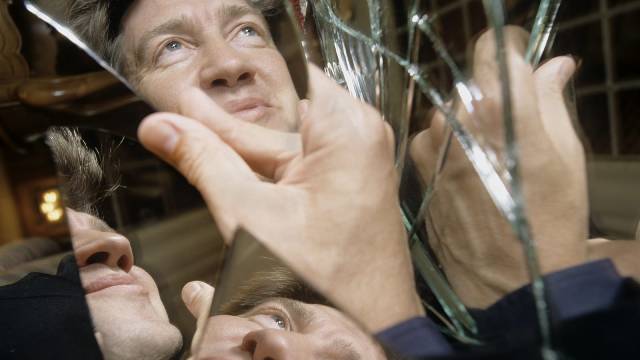
Many years ago, when I submitted a review to a journal, the editor responded politely with an admonition to beware of interpreting any movie through a “key” I thought I had discovered. I took that to heart; such an approach is reductive, closing off other potential avenues because it’s apt to limit what you see. So I was wary about the idea of Lynch/Oz (2022), Alexandre O. Philippe’s seventh feature-length meditation on iconic cinematic subjects – he has previously explored George Lucas’s battle with fans over possession of Star Wars; the cultural appeal of zombies; the shower scene in Psycho; the making and meaning of both Alien and The Exorcist; and the transformation of Monument Valley from landscape into multi-purpose symbol. As the title bluntly implies, this six-part essay seeks to place Victor Fleming’s The Wizard of Oz (1939) as the ur-text of David Lynch’s body of work.
Having watched the film twice now, I remain ambivalent. This may in part be due to the fact that, unlike the people interviewed by Philippe – and apparently Americans in general – Fleming’s musical fantasy was never an indelible part of my own childhood. Although I have no clear memory, I suspect that while I knew of its existence I may not have seen it until my teens, an age when its artificiality would have been off-putting to me, all those obvious studio sets and musical numbers making it more vaudeville revue than movie. Which means that, all these years later, I can recognize its cultural position without having any particular personal feeling for it.
For the seven people who provide the six chapters of Lynch/Oz, however, there’s obviously a deep connection rooted in repeated childhood encounters, and their own experiences are assumed to be shared by Lynch himself. This is not so surprising as Lynch is quoted as saying that “not a day goes by that I don’t think of The Wizard of Oz“. And as the numerous clips in Philippe’s film show, his work is indeed filled with visual and narrative references to Oz – the bifurcated stories of Lost Highway and Mulholland Dr., the crossing between alternate realities in Blue Velvet and Inland Empire, the ubiquitous curtains in Twin Peaks, the multiple instances of characters wearing red shoes … not to mention names: Dorothy in Blue Velvet, Garland in Twin Peaks, and the mysterious Judy who is repeatedly referred to in the latter.
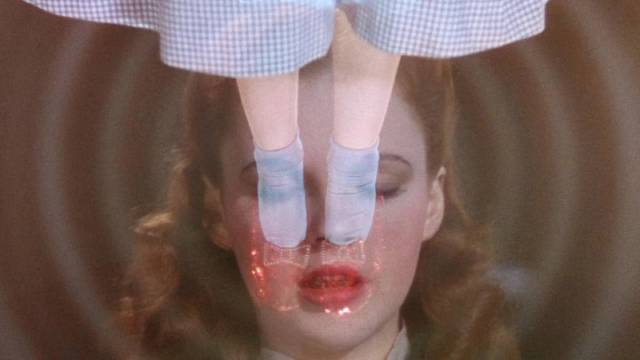
All of which seems to make it undeniable that Oz is deeply embedded in Lynch’s work, though in all the times I’ve watched his films I’d never really registered the connections. In fact, and I’m not sure what this means if anything, the only Lynch film I’ve never liked is Wild at Heart (1990), the one film in which these references are explicitly foregrounded – it has always struck me as a strangely conscious attempt by Lynch to make a “David Lynch film”, not exactly self-parody so much as an attempt to codify what is so distinctive in his cinematic practice. And so perhaps all the tediously overt references to The Wizard of Oz in Wild at Heart may in fact confirm Philippe’s thesis that Fleming’s film really is Lynch’s ur-text.
Seen from half a dozen frequently overlapping angles, this argument seems irrefutable. In the opening chapter, critic Amy Nicholson asserts that Oz is the quintessential American fairytale, which also embodies the essence of cinema – the grinding reality of Kansas abruptly opens up to the glorious Technicolor fantasy-adventure of Oz, where Dorothy learns some important life lessons before re-emerging into the light of Kansas day with a new appreciation of her familiar home.
Filmmaker Rodney Ascher (no stranger himself to this kind of exploration, having made Room 237 [2012] about obsessive interpretations of Stanley Kubrick’s The Shining [1980]) posits the Oz narrative as a particular expression of the archetypal hero’s journey – the first instance in Philippe’s film of a generalization which dilutes the specificity of the core argument; the echoes of Oz in Lynch could apply to virtually any story, thus making the connection essentially meaningless.
John Waters’ chapter stands out because it’s less of a critical argument and more of a personal reminiscence about his connection to Lynch – of a similar age, with a shared ambivalence about the ’50s in which they both grew up, they each began as an outsider artist, with Waters being unexpectedly instrumental in the early success of Eraserhead, which he saw on its original midnight release and enthusiastically promoted to his own audience. Although very different as artists, they have shared a life-long bond rooted in affection and mutual admiration.
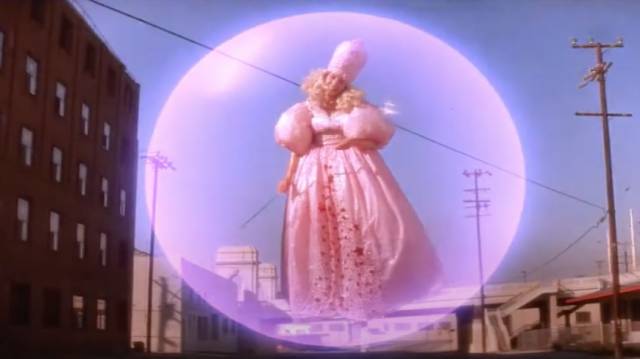
Perhaps the most engaging chapter has filmmaker Karyn Kusama beginning with her initial encounter with Lynch in a diner; she then speaks of a Q&A following a screening of Mulholland Dr. and goes on to dissect the ways in which that film constantly slips between dream and reality in much more subtle ways than The Wizard of Oz. She also calls attention to the numerous times in which Lynch’s characters lip sync to recorded songs, suggesting that this might go back to the moment in the opening section of Oz in which the unhappy Dorothy suddenly lip syncs to her own voice singing “Somewhere Over the Rainbow”, the first moment in the film where “reality” is disrupted.
Justin Benson and Aaron Moorhead open things up a little in their chapter when they speak of the discrepancy between the character of Dorothy – sweet, innocent, open to experience – and Judy Garland, who at the time of production was already being manipulated by the studio in damaging ways which would have a life-long impact. This dichotomy can be seen reflected in the two versions of the character played by Naomi Watts in Mulholland Dr., the wide-eyed dreamer Betty Elms who arrives in Hollywood and wins everyone over and the ruined Diane Selwyn whose ambitions have completely failed. Could the strange phantom of Judy which lurks in the fabric of Twin Peaks be the tortured spirit of Judy Garland herself?
In the sixth and final chapter, filmmaker David Lowery talks of the tension which characterizes the transition between childhood and adulthood, the fear of the latter causing us to cling as long as we can to the former. Blue Velvet and Twin Peaks, like The Wizard of Oz, have characters emerging from domestic security into a world fraught with dangers, returning changed, even destroyed by their experiences. Then in the closing section of the chapter, as Lowery speaks of artists reiterating in different yet similar ways what has inspired them, Philippe presents a lengthy montage of clips from a varied group of directors in which we see explicitly this pattern of repetition, reinforcing the idea that art itself is a way for artists to work through the concepts which first led them to create. For Lynch, it is suggested, this inspiration was his childhood encounter with The Wizard of Oz.
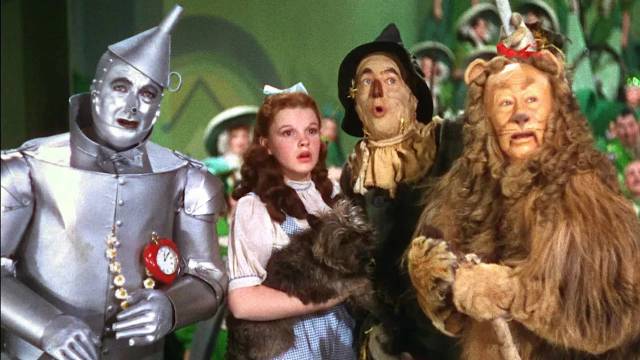
Although I have never given much thought to The Wizard of Oz, I did revisit it between my two viewings of Lynch/Oz and found it darker than I remembered – in itself an interesting reflection of Lynch’s work. As innocent as she is, Dorothy nonetheless kills two powerful women during her journey, albeit “accidentally” – the Wicked Witch of the East is crushed by the house as it’s dropped in Oz by the tornado, and towards the end her sister the Wicked Witch of the West is destroyed when Dorothy tosses a bucket of water over her. In Blue Velvet, Jeffrey, obsessed with Dorothy Vallens, ends up killing the monstrous Frank Booth before returning home. But while Dorothy’s return in The Wizard of Oz seems reassuring, Jeffrey’s home seems oddly changed, less real in light of his recent experiences, perhaps because unlike Dorothy he has actually been traumatized by all the violence.
Here, the tension between home and the world outside seems irreconcilable, the latter making it impossible to return fully to the former. The Wizard of Oz seems more emphatically conservative; Dorothy’s conclusion that not only is there “no place like home” but that everything she’ll ever need or want is right there in her back yard is a rather chilling lesson to take from her Technicolor excursion into the larger world, a capitulation to fear of the unknown. Lynch’s work never offers anything this decisive, rather leaving the audience with an uneasy, precarious ambivalence, poised in the permeable borderland between alternate realities, neither of which offers a comfortable security. There might be a longing to return to what seems a simpler, more optimistic time (the faux ’50s of Blue Velvet), but there’s too much honesty to pretend that this is really possible.
As for that starting point, the idea that The Wizard of Oz may provide a “key” for understanding Lynch’s work – what do all these connections actually mean? Many of the shared elements pointed out by the people interviewed by Philippe equally apply to countless other movies (and stories which predate cinema), so it appears that L. Frank Baum, Victor Fleming and Lynch are all drawing from an older, deeper cultural well.
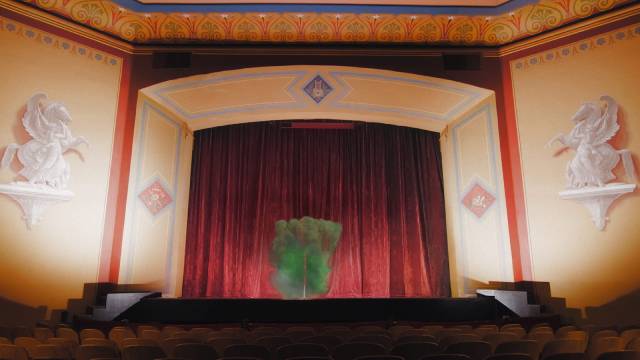
But at the risk of contradicting myself, I might suggest that by the end of Lynch/Oz I had actually detected a key linking Lynch’s work to Fleming’s film. Famously a creature of habit, Lynch is known for all the years when he would go to Bob’s Big Boy for the same lunch every day. In a clip from the Charlie Rose show included by Philippe, he explains that having a fixed, predictable structure for the mundane things in life frees you from trivial distractions so that you can fly off in other directions to explore ideas. Could it be that The Wizard of Oz is akin to those Bob’s Big Boy lunches, a stable ground from which he has been able to launch himself into those subconscious explorations from which his strange, enigmatic and unsettling films have emerged?
A couple of final points: after four decades and multiple viewings, it occurs to me that Eraserhead’s Man in the Planet may well be a dark analogue for the Wizard himself, desperately grappling with his controls in an attempt to impose his will on a world which refuses his authority. For the Wizard this failure is embarrassing; for the Man in the Planet, it’s apocalyptic. And what is Twin Peaks’ Man from Another Place if not a Munchkin?
*
Released by Criterion on the new Janus Contemporaries label, Lynch/Oz is visually striking. There are no on-camera interviews; rather, apart from occasional archival clips, the film consists entirely of clips from what seems like hundreds of movies (it must have been a clearance nightmare) – many, of course, from The Wizard of Oz itself and various Lynch films, but also numerous other films used to illustrate points being made by the interviewees, often using split-screen juxtapositions. Sometimes this imagery is enlightening, sometimes it seems obvious, even mundane (yes, many movies show characters walking – we walk all the time in the real world, so it doesn’t necessarily signify anything and certainly doesn’t need the precedent of The Wizard of Oz to justify showing it on screen). The sheer quantity of material occasionally becomes exhausting, but at times it makes you want to seek out a movie you’re not familiar with or which you only vaguely remember. (I’ll have to take another look at H. Bruce Humberstone’s I Wake Up Screaming [1941], which I remember mostly for Laird Cregar, but not for the fact that “Somewhere Over the Rainbow” was used as a musical motif throughout the film even though The Wizard of Oz hadn’t yet risen from its status as a costly flop.)
Apart from a trailer, the only extra is an interview with Philippe in which he explains that after interviewing his subjects, he distilled each session down into a script which he then had the subjects record. In this way, he shaped their ideas into something more structured which nonetheless uses their own words. Even with this process, there are times when the film occasionally seems to drift off topic and become a little vague.
In the end, I’m not sure that any of this has given me a new understanding of Lynch’s work, but as a more general case study of how an artist absorbs influences and forms them into new and independent works, Lynch/Oz is not without interest.
Comments